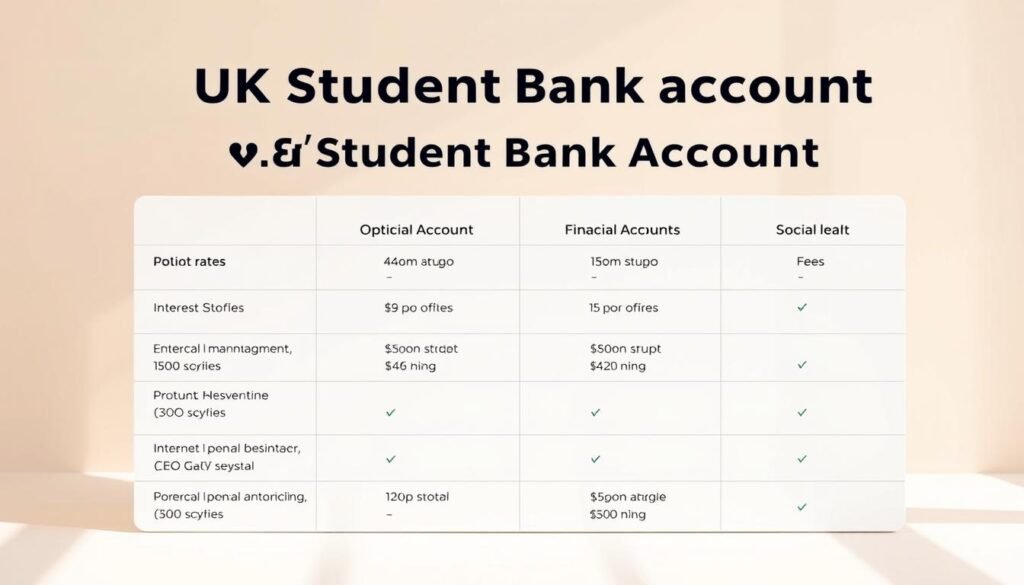
Compare the best student savings account UK banks for your needs

Ready to make your money work harder while you study? Picture arriving at university with a suitcase, a timetable and one bank card. You want an account that fits campus life, not the other way round.
In this guide you’ll quickly compare how high‑street and challenger names Santander, NatWest, Barclays, HSBC, Halifax, Lloyds and Nationwide pair practical perks with useful savings tools. We look at free railcards, trial services, switching incentives and linked regular savers that can boost interest while keeping funds available.
You’ll see which student bank account options combine a regular saver with a 0% overdraft safety net, how tiered overdraft limits rise over the years of your course, and what proof you’ll need to apply so the account is ready for term one.
Next, we’ll map out simple steps to set up, automate and review your banking so you save more, spend smarter and avoid fees through each year of study.
- What you’ll get from this guide to the best student savings account UK banks
- At-a-glance comparison: top UK student accounts and savings add‑ons
- Which UK banks stand out for students right now
- Savings features that matter while you study
- Eligibility, documents and timing: opening your student account today
- Overdrafts, credit scoring and staying in control
- How to choose the best student savings account UK banks for your goals
- Actionable steps: set up, optimise, and review each academic year
- Images to help you compare at a glance
- Make your move now and start saving while you study
What you’ll get from this guide to the best student savings account UK banks
We cut through marketing to show which account setups and linked saver rules will protect your cash and grow your balance during term time.
Your commercial intent: save more, spend smarter and avoid fees. You’ll get clear, actionable steps to open a current account, link a Regular Saver and set app rules that move money automatically.

Your commercial intent: save more, spend smarter, avoid fees
- Understand how an arranged overdraft works and how to avoid unarranged charges.
- See which bank accounts combine fee-free perks with a linked saver that actually pays.
- Get quick next actions you can do in the app once your account is live, such as enabling alerts and the first transfer.
How we evaluate bank and savings features today
We weigh headline offers 0% overdraft tiers, Regular Saver rates and app tools against real access rules and eligibility. Our scoring compares fees, access, switching terms and how easy it is to keep earning advertised benefits.
At-a-glance comparison: top UK student accounts and savings add‑ons
This compact comparison shows overdraft tiers by year, linked Regular Saver rates and the main perks so you can shortlist quickly.

| Provider | 0% overdraft (year) | Linked saver / rate | Perks & fees |
|---|---|---|---|
| Santander Edge Student | £1,500 yrs 1–3; up to £2,000 year 5 | Regular Saver access | 4‑yr Railcard; My Money Manager |
| HSBC Student | £1,000 rising to £3,000 by yr 3 | 5.00% AER on £25–£250/m | No monthly fees; digital wallet |
| NatWest | £500 term 1; up to £3,250 by yr 3 | Linked saver options | £85 + tastecard; app focus |
| Barclays / Nationwide / Others | From £1,000; varies or none (Monzo/Metro) | Linked or in‑credit interest options | Perlego, travel card perks, switching offers |
Quick notes:
- Check eligibility criteria such as UCAS codes and residency before you apply.
- Look at access rules for each linked saver monthly deposit limits and withdrawal terms affect how you save.
- Compare overdraft headroom by year so your credit cover matches your course needs.
For deeper comparisons visit our Student Banking and Savings Accounts sections, or see providers’ pages for full terms (external links are nofollow).
Which UK banks stand out for students right now
These short profiles show who benefits from each provider’s perks, overdraft rules and app tools.
Santander Edge Student: eligibility starts at 18 with UCAS proof. You get a free 4‑year 16–25 Railcard and a tiered 0% overdraft (£1,500 in years 1–3; up to £2,000 by year 5). The My Money Manager tool and a linked Regular Saver help you budget and build a balance.
Who it’s for: you travel between term and home often and want a steady overdraft that ramps up as your course continues.
HSBC Student Account
Features: guaranteed 0% arranged overdraft from £1,000 rising to £3,000 by year 3, a 5.00% AER Regular Saver (£25–£250/month, 12 months) and app wallet support. Eligibility includes 18+, UCAS proof and three years UK residency.
Who it’s for: you value early overdraft cover, a competitive saver rate and fee-free app tools. For details see Overdrafts Explained and the provider page (external, HSBC).

NatWest
Offers an upfront £85 plus a four‑year tastecard and an app-first sign-up. Overdrafts start lower in term one (£500) and can reach £3,250 by year three. Apply online and make this your main account to access full perks.
Nationwide
Known for travel-friendly card use, linked saver choices and frequent vouchers. No overseas credit card fees and flexible Flex options make it handy if you spend time abroad for study or placements.
Lloyds, Halifax, Bank of Scotland
These providers push switching bonuses, cashback at retailers and some in‑credit interest on small balances (Halifax offers in‑credit rates and a post‑grad 0% window). They suit you if switching incentives and small interest beats suit your routine.
Barclays
Comes with a free 12‑month Perlego subscription for textbooks and a rising 0% overdraft (from £1,000 to £1,500). If you use digital learning resources, this perk can cut your term costs.
Monzo and Metro
Fast to open and app‑centric. They do not normally offer student-specific overdrafts, so use them as a secondary current account for Pots and instant spending control.
"Match the overdraft and perks you need to your typical term-day spending that keeps fees low and flexibility high."
- Want to switch? See Switching Banks for a step-by-step guide.
- Check each provider’s terms for exact limits and saver rules on their site (external, nofollow).
Savings features that matter while you study
Understanding how different pots work helps you keep cash handy for term costs and still earn decent returns.
How Regular Savers work
Regular Savers are usually fixed for a set term, often 12 months. You pay in a set amount each month and the rate applies while you keep to the plan.
Examples: HSBC pays 5.00% AER on £25–£250 a month for 12 months. Santander and Nationwide let you link a saver to your student current account so transfers are simple.
Remember that early withdrawals can reduce or void interest. Check deposit caps and withdrawal rules before you sign up.
In‑credit interest vs locked pots
If you keep small buffers, a high in‑credit rate can beat locking cash away. Halifax offers up to 5% on balances up to £500 handy if you need immediate access.
Trade‑off: top headline rates often mean stricter access. If your spending or course costs vary by term, use a mix of locked and flexible pots.
- Automate: set a monthly app transfer on payday to pay yourself first.
- Tag transfers in your budgeting tool so they aren’t missed during busy exam periods.
- Review at term end and move cash if the follow‑on rate is lower.
For more detail, see our Savings Accounts guide and the Budgeting & Tracking resource.
Eligibility, documents and timing: opening your student account today
Start here getting eligibility clear and paperwork ready avoids delays that can push your card or funding past freshers week. Read the criteria, gather proof and apply once your place is confirmed.
Age, residency and UCAS proof you’ll need
Check age and residency first. Some providers accept applicants from 17, others from 18, and many want three years’ UK/CI/IoM residency.
Have your 16‑digit UCAS status code ready. If you don’t have it, use a headed offer letter or UCAS Track print‑out as proof.
When to apply and whether you can switch later
Apply as soon as your place is firm so your current account and card arrive in good time. NatWest lets you apply up to six months before a course starts.
HSBC requires 18+ and three years’ residency; it accepts some postgraduate courses and converts to a Graduate Account after you finish.
- Gather passport or driving licence plus proof of address for fast ID checks.
- Keep your phone number up to date for security codes and overdraft alerts.
- Save application reference numbers in case verification takes extra time.
Want to switch later? Use the Current Account Switch Service to move direct debits within seven working days. For full eligibility details, check providers’ terms on their sites.
Overdrafts, credit scoring and staying in control
Knowing how arranged and unarranged overdrafts affect your credit helps you avoid surprise costs during term time. This short guide explains how pre‑agreed limits work, what triggers warnings, and how to keep your file healthy.
How 0% arranged overdrafts work and typical year‑by‑year limits
An arranged overdraft is a pre‑agreed buffer on your current account. Many providers offer a 0% arranged overdraft for students initially for example a 0% on £1,000 that can rise to £2,000 in year two and £3,000 in year three, subject to status.
Use only the headroom you need. If your income changes, ask your bank to adjust limits rather than risking unarranged borrowing.
Unarranged overdrafts, alerts and your credit file
Unarranged overdrafts can cause declined payments and fees. Banks usually send SMS or app alerts when you’re close to or in the red. Do not opt out of phone or app alerts.
- Act fast: clear negative balances as soon as your term funds arrive.
- Monitor: enable daily balance alerts around rent and bill dates.
- Report: sustained unarranged overdrafts over 30 days may be reported to credit reference agencies and harm your credit.
For detail on how these systems work, see Overdrafts Explained and our Build Your Credit guide.
How to choose the best student savings account UK banks for your goals
Decide what matters most rail travel, overdraft cover, high interest or signup perks and match a bank to that need.
If travel is key: railcards and fee‑free spending abroad
Value tip: a Santander 16–25 Railcard saves a third on fares and can beat a small rate advantage. If you go overseas, Nationwide’s no‑fee card use protects your spending.
If cashflow is tight: overdraft headroom and app tools
Pick a bank with tiered 0% overdraft limits such as HSBC or NatWest. Their limits rise by year three and give you breathing room.
Also choose an app that sends daily alerts and helps tag spending. That reduces fees and keeps your credit file intact.
If saving is the priority: Regular Saver and interest on balances
Look at the headline rate and the monthly cap. HSBC’s 5.00% Regular Saver and Halifax’s 5% in‑credit on small balances suit different goals.
Check access rules: early withdrawals can void interest, so match access to how you use money during term.
If you love perks: switching cash, food and entertainment discounts
Add up the real value of sign‑up offers like NatWest’s £85 + tastecard, Barclays’ Perlego or Deliveroo vouchers from switching banks.
- Match the perk to your course calendar Perlego helps heavy reading terms.
- If you travel a lot, value rail savings over tiny interest gains.
Quick next steps: score your priorities, visit our Student Banking, Travel Money and Savings Accounts pages, then compare fees and access before you apply.
Actionable steps: set up, optimise, and review each academic year
Start with a quick checklist that gets your current account ready, links a Regular Saver and sets alerts so money moves where you need it each term.
Open the right current account and link a Regular Saver
Today: shortlist two or three providers that match your priorities and check eligibility. Have your UCAS code or offer letter ready so you can open student quickly.
Apply online and opt in to an arranged overdraft sized for real need. Banks let you change limits later via app, phone or branch set a calendar reminder to review after your first term.
Automate transfers, track spending, and set overdraft alerts
Automate the money flow: link and fund your Regular Saver, then schedule a monthly transfer for the day your funding arrives.
- Turn on app insights and category budgets and add SMS low‑balance and overdraft alerts.
- Use the Current Account Switch Service to move direct debits and standing orders; expect completion within seven working days.
- Create separate pots for rent, travel and books so essentials are ring‑fenced.
Review each year: at year‑end check saver maturity, overdraft usage and whether switching could improve your terms for the next year.
For practical guides on budgeting, arranged overdraft rules and linked saver options, see our Budgeting, Overdrafts and Savings Accounts pages.
Images to help you compare at a glance
Visuals make choices faster. A compact matrix, icon set, timeline and flowchart help you spot key differences in overdraft tiers, saver caps and perks without reading long tables.
Matrix: compares 0% overdraft by year and Regular Saver rules for leading providers so you can see headroom and interest at once.
Icons: map Railcard, tastecard, Perlego and cashback perks to the relevant student bank so you spot which offers suit your term routine.
Timeline: shows application windows, switch deadlines, saver maturity and annual overdraft reviews so you don’t miss key dates in your university year.
Flowchart: routes you to the right bank account based on priorities travel, cashflow, interest or perks so selecting a student current is quicker.
- Images sit next to the comparison table and decision sections for clear context.
- Use the visuals to confirm access, range and any fees before you apply.
Make your move now and start saving while you study
Shortlist two providers, gather your UCAS proof and open student online so your card and overdraft arrive before term starts.
Pick a plan that balances a linked saver with the right 0% overdraft for your first year. Prioritise tools that automate transfers and guard your money from unnecessary fees.
Lock in perks you will use, set a Regular Saver and schedule a monthly transfer today. If you need to change later, use the Current Account Switch Service to move bank accounts within seven working days and keep direct debits.
Next step: visit our Student Banking and Comparison pages, check eligibility and submit your application in under 15 minutes.
If you want to know other articles similar to Compare the best student savings account UK banks for your needs you can visit the category Finance.






Leave a Reply